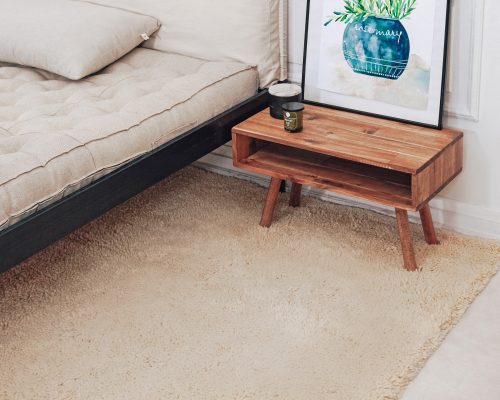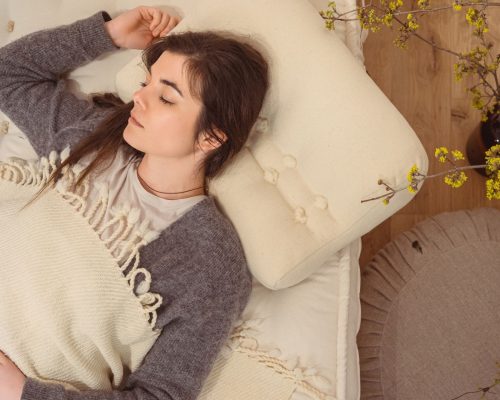
A home filled with healthy furniture is just as important as healthy food. More and more research points to the dangers of some toxic chemicals and synthetic materials used to manufacture home furnishings like mattresses and bedding.
There are thousands of potentially harmful chemicals used across the board when making up these items. And there are just as many marketing terms that are used to convince us we are making healthy and environmentally conscious choices. Many of these terms are quite ambiguous so we decided to compile a list of the most frequently used words on labels and ads, so we can help you to become an empowered savvy home furnishings shopper.
We see these so often but do you actually know what is the difference between Natural, All Natural, Organic, and Certified Organic? We’ve got you covered on this.
Healthy Home Textiles Glossary of Terms
‘Natural’
You can often see this word on food and home products labels. We associate it with materials found or grown in nature. But in fact, there are no specific requirements for using this word on a label. It doesn’t specifically point out what materials there could or could not be inside the package or how were these ‘natural’ materials treated while creating the final product.
No synthetic man-made fabrics and materials can ever be called ‘natural’ but the final product can actually be labeled as such even if it contains chemicals and synthetics alongside the natural materials.
Examples of man-made fabrics and textiles include foam, nylon, polyester, polyvinyl chloride (PVC), spandex, rayon, acetate and acrylic.
‘All-natural’
All-natural’ items are those in which every ingredient and component is made of natural materials and there are no synthetics in the composition. Getting an ‘all-natural’ product should give you a better piece of mind that you are making a safe choice, compared to those with a just ‘natural’ label.
‘Eco’
Also known as ‘environmentally-friendly’ أو ‘green’. This term refers to the impact that the products or materials and their manufacturing process have on the environment.
To be considered environmentally friendly they should have minimal or no impact on the environment. Be it during their extraction, sourcing, growing, or production. And this is where it gets a bit fuzzy because, again, there is no clear definition on what is acceptable in terms of impact and what is not.
‘Non-toxic’
This term is also not regulated. It is mostly used to signify the lack of synthetics or chemicals inside the finished product (or material) that have toxic effects on your health or the environment. Unfortunately, according to guidelines by the Consumer Product Safety Commission, as long as the product kills less than half the lab rats during testing, it can be labelled as “non-toxic”.
‘Toxin free’
Products created without the use of potentially toxic, carcinogenic, or poisonous ingredients that could be questionable in safety. This means there still could be chemicals inside, just not the ones that are proven to be toxic.
‘Chemical Free’
This term is similar to non-toxic but implies no chemicals were used whatsoever. These can be all sorts of finishes, dyes, stabilizers, anti-wrinkle chemicals, fire and flame retardants, and so on.
‘Organic’ and ‘Certified organic’
In order to be organic, materials should be grown in an environment that was not treated with chemical pesticides, herbicides, fungicides, and artificial fertilizers. Also organic items cannot be genetically modified.
If something is labeled as organic without being certified as organic it doesn’t mean that it is not organic per se.
If the label states ‘organic’ and not ‘certified organic’ that means that the item has not been independently tested to verify that it complies to a set of standardized requirements of the organic certificate.
Oftentimes companies simply overgo certification due to the high costs involved, even though their products are pure and comply to the requirements to get certified. This is especially difficult for small companies with limited budgets.
So don’t hesitate to contact the companies directly and ask them your questions to be sure you are getting a product as pure as possible, even though they lack formal certification.
Popular certificates for textiles and home furnishings

معيار GOTS (المعيار العالمي للمنسوجات العضوية)
GOTS is one of the most recognizable organic certificates, and specifically in North America. The standard covers the processing, manufacturing, packaging, labeling, trading, and distribution of all textiles. It evaluates all chemicals used in the processes, to meet basic requirements on toxicity and biodegradability/eliminability and does not allow the use of toxic heavy metals, formaldehyde, aromatic solvents, functional nano particles, genetically modified organisms (GMO) and their enzymes, no chlorine bleaching, no azo dyes, phthalates, and PVC.
يجب أن يحتوي منتج المنسوجات الذي يحمل علامة GOTS بدرجة "عضوي" على ألياف عضوية معتمدة من GOTS بحد أدنى 95%، بينما يجب أن يحتوي المنتج الذي يحمل علامة "مصنوع من مواد عضوية" على ألياف عضوية معتمدة من GOTS بحد أدنى 70%.

USDA Organic
This certificate is issued by the US government. It only covers that raw natural fibers used to make the textiles and home products, such as cotton, wool, and flax. These must be organic, that is they meet the National Organic Program standards. However, there is no regulation for what other ingredients are used in the making of the final products. So toxic dyes and finishes can still be present. Be sure to read the fine print and ask companies your questions to clarify anything you need to know before purchasing.

معيار أوكو-تكس 100
Oeko-Tex is one of the oldest and most reliable standards out there. Although less recognizable by customers outside of Europe, when you see it on a product you can be certain it’s been tested for hundreds of chemicals and harmful substances. These include substances in the ready product but also substances that are activated and become harmful during the normal use of the product.
وتتطلب انبعاثات منخفضة من المركبات العضوية المتطايرة (VOCs) والفورمالدهايد من الرغوة، بينما تحظر أيضًا استخدام بعض مثبطات اللهب الكيميائية والملونات والأصباغ المسببة للحساسية.
يتضمن معيار أويكو-تكس 100 لوائح تتعلق بأصباغ الآزو المحظورة والفورمالدهايد والنيكل وغيرها. يتم أيضًا اختبار المواد الكيميائية الضارة بالصحة إذا لم يتم تنظيمها قانونيًا بعد. تراعي المتطلبات أيضاً الاستخدام المقصود من المنسوجات. كلما زادت كثافة ملامسة الجلد لمنتج المنسوجات، زادت صرامة القيم الحدية لكل فئة من فئات المنتجات.
فئة المنتج I: مقالات للرضع والأطفال الصغار
الفئة الثانية من المنتجات: المواد المستخدمة بالقرب من الجلد
فئة المنتج الثالثة: المواد المستخدمة بعيدًا عن الجلد
فئة المنتج IV: المواد
لا تصدر هذه الشهادة إلا من قِبل Oeko-Tex نفسها، مما يضمن استيفاء المعايير الصارمة المذكورة أعلاه، مما يمنح الثقة للعملاء.
***
At Home of Wool, we focus on making healthy wool mattresses, bedding, and home décor items for you and your loved ones, out of the most natural and pure materials available, using only wool, linen, cotton, and silk. We never use finishes, flame retardants, synthetics, and chemicals of any sort.
No matter where you are looking to shop for your next home furnishings purchase, we always advise to first find out what materials the product is made of throughout its production process. This small but often overlooked step will help you find out if the item is a healthy choice for your home and for the planet.




information presented in this article is of great value .language is precise and easy to relate to .
i know this is going to help me relate to labels more effectively and make my buying more conscious .so thank you for this share.
Hello, can you please tell me where your products are made? In what country? Your products look amazing. Thank you!